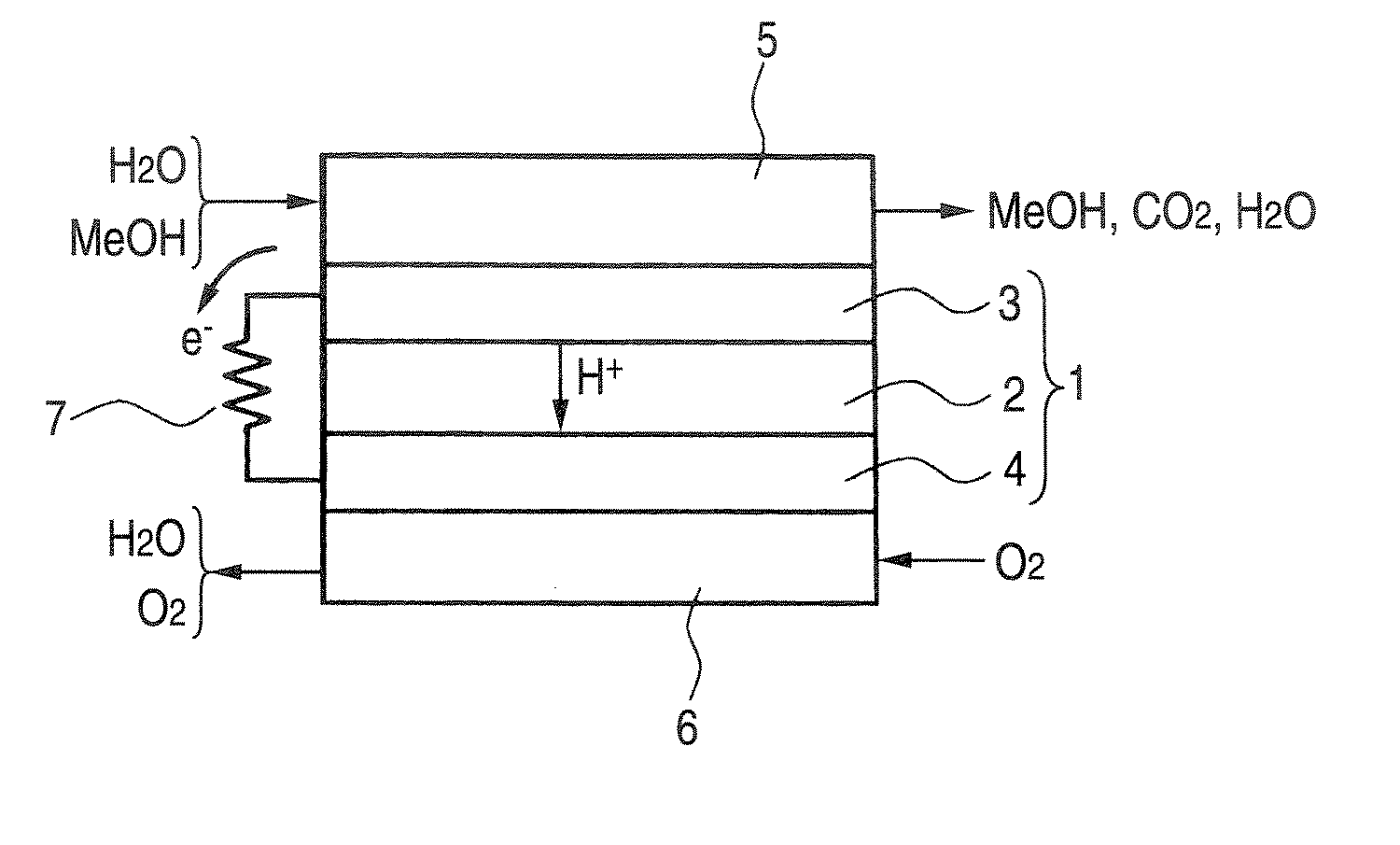Electrolytic membrane, process for producing the same, membrane electrode assembly, fuel cell and method of operating the same
a technology of electrolyte and membrane, which is applied in the direction of non-aqueous electrolyte cells, cell components, sustainable manufacturing/processing, etc., can solve the problems of serious decrease of proton conductivity, inability to obtain stable output, and infiltration of methanol, so as to improve the performance of direct methanol type fuel cells (dmfc) and improve the performance of methanol type fuel cells. , the effect of less methanol cross-over
- Summary
- Abstract
- Description
- Claims
- Application Information
AI Technical Summary
Benefits of technology
Problems solved by technology
Method used
Image
Examples
first embodiment
Electrolytic Membrane
[0034] An electrolytic membrane comprising a porous membrane substrate filled with a cross-linked polymer electrolyte having at least a structural component shown by the following chemical formula 1:
wherein A represents a repeating structural unit having an aromatic hydrocarbon group substituted by at least a sulfonic acid group, B represents a repeating structural unit having a nitrogen-containing hetero ring compound residue or the sulfate, hydrochloride or organic sulfonate thereof, C represents a repeating structural unit having a divalent hydrocarbon group, and X, Y and Z represent mol fractions of respective repeating structural units in the chemical formula 1, with 0.34≦X≦0.985, 0.005≦Y≦0.49, 0.01≦Z≦0.495 and Y≦X and Z≦X.
[0035] The cross-linked polymer electrolyte is specifically represented by the following chemical formula 7:
wherein X, Y and Z are the same as defined above, at least one of R1, R2, R3, R4 and R5 represents a sulfonic acid group (...
second embodiment
Production Process 1
[0049] A process for producing the electrolytic membrane which is the first embodiment of the invention will be described in detail below.
[0050] The production process of this embodiment includes a step of impregnating a porous membrane substrate with a monomer composition comprising the vinyl group-having, nitrogen-containing hetero ring compound of the foregoing chemical formula 3, the vinyl group-containing aromatic compound monomer of the chemical formula 4, the cross-linking agent of the organic compound monomer having two or more vinyl groups of the chemical formula 4, and a radical initiator or a monomer solution prepared by adding a suitable amount of a solvent to the monomer composition (impregnating step), a step of polymerizing this monomer composition (polymerizing step) and a step of sulfonating the composite membrane obtained in the preceding step to thereby produce an electrolytic membrane having a sulfon group (sulfonating step). This process ca...
third embodiment
Production Process 2
[0061] In the second embodiment, a production process of sulfonating after polymerization of the monomers including the nitrogen-containing hetero ring compound for obtaining the polymer of the chemical formula 2 is shown. Alternatively, it is also possible to conduct polymerization using a monomer having a sulfonic ester group, and then hydrolyze the sulfonic ester group of the resulting polymer to convert it to a polymer having a sulfonic acid group in the side chain. Such production process will be described below.
[0062] This production process includes at least a step of impregnating a porous membrane substrate with a monomer mixture containing a monomer represented by the following chemical formula 6, a monomer represented by the following chemical formula 4 and a monomer represented by the following chemical formula 5 (impregnating step), a step of polymerizing the monomer mixture by heating the porous substrate impregnated with the monomer mixture (polym...
PUM
| Property | Measurement | Unit |
|---|---|---|
| pore size | aaaaa | aaaaa |
| pore size | aaaaa | aaaaa |
| porosity | aaaaa | aaaaa |
Abstract
Description
Claims
Application Information
 Login to View More
Login to View More - R&D
- Intellectual Property
- Life Sciences
- Materials
- Tech Scout
- Unparalleled Data Quality
- Higher Quality Content
- 60% Fewer Hallucinations
Browse by: Latest US Patents, China's latest patents, Technical Efficacy Thesaurus, Application Domain, Technology Topic, Popular Technical Reports.
© 2025 PatSnap. All rights reserved.Legal|Privacy policy|Modern Slavery Act Transparency Statement|Sitemap|About US| Contact US: help@patsnap.com



